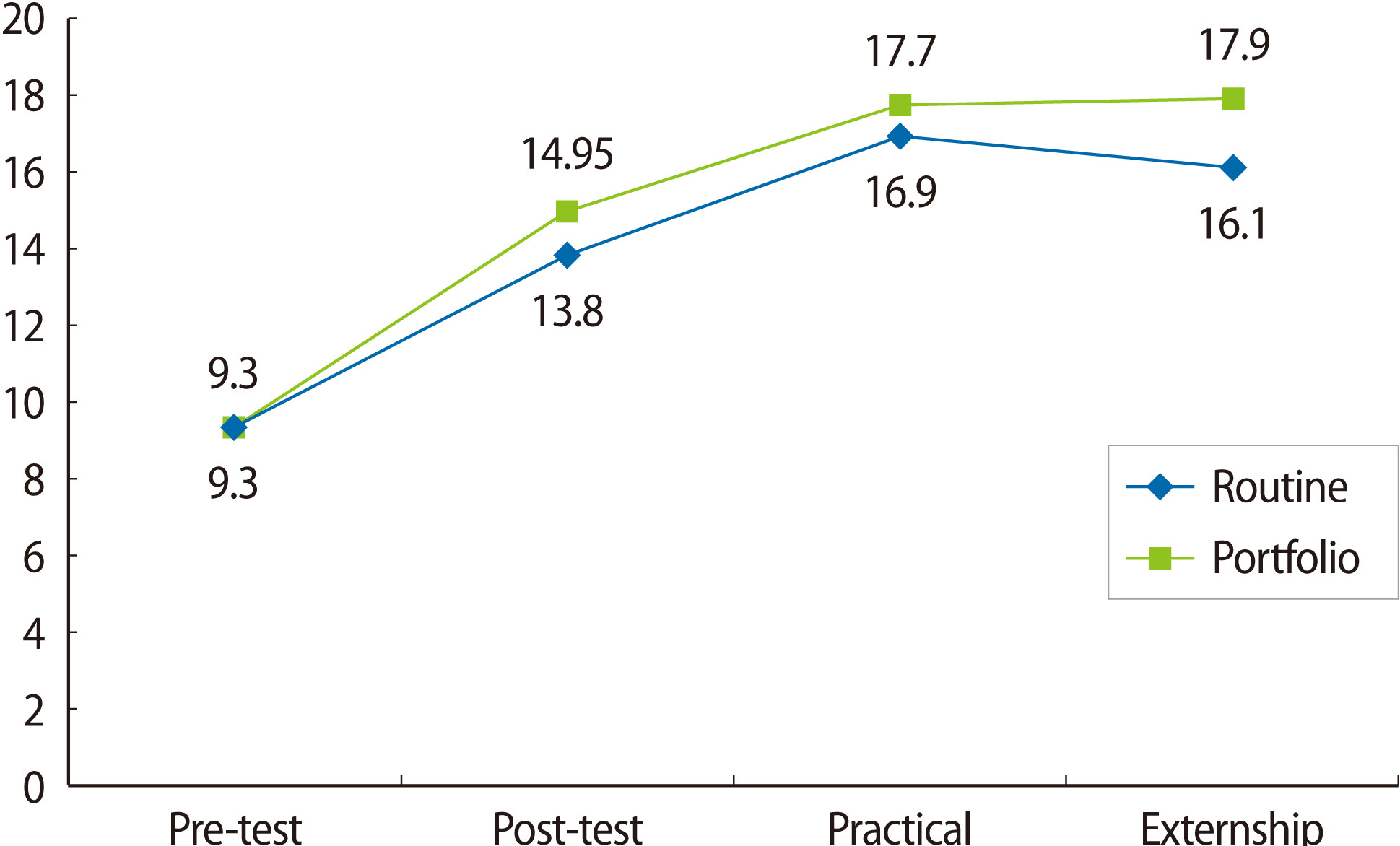J Educ Eval Health Prof.
2011;8:2.
Effect of portfolio assessment on student learning in prenatal training for midwives
- Affiliations
-
- 1Department of Midwifery, Shaheed Beheshti University of Medical Sciences, Tehran, Iran. n_kariman@sbmu.ac.ir
Abstract
- The tendency to use portfolios for evaluation has been developed with the aim of optimizing the culture of assessment. The present study was carried out to determine the effect of using portfolios as an evaluation method on midwifery students' learning and satisfaction in prenatal practical training. In this prospective cohort study, all midwifery students in semester four (n=40), were randomly allocated to portfolio and routine evaluation groups. Based on their educational goals, the portfolio groups prepared packages which consisted of a complete report of the history, physical examinations, and methods of patient management (as evaluated by a checklist) for women who visited a prenatal clinic. During the last day of their course, a posttest, clinical exam, and student satisfaction form were completed. The two groups' mean age, mean pretest scores, and their prerequisite course that they should have taken in the previous semester were similar. The mean difference in the pre and post test scores for the two groups' knowledge and comprehension levels did not differ significantly (P>0.05). The average scores on questions in Bloom's taxonomy 2 and 3 of the portfolio group were significantly greater than those of the routine evaluation group (P=0.002, P=0.03, respectively). The mean of the two groups' clinical exam scores was significantly different. The portfolio group's mean scores on generating diagnostic and therapeutic solutions and the ability to apply theory in practice were higher than those of the routine group. Overall, students' satisfaction scores in the two evaluation methods were relatively similar. Portfolio evaluation provides the opportunity for more learning by increasing the student's participation in the learning process and helping them to apply theory in practice.
Keyword
MeSH Terms
Figure
Reference
-
1. Parboosingh J. Learning portfolios: potential to assist health professionals with self-directed learning. J Contin Educ Health Prof. 1996; 16:75–81.
Article2. Van Tartwijk J, Driessen E, Van Der Vleuten C, Stokking K. Factors influencing the successful introduction of portfolios. Qual High Educ. 2007; 13:69–79.
Article3. Sahu SK, Soudarssanane M, Roy G, Premrajan K, Sarkar S. Use of portfolio-based learning and assessment in community-based field curriculum. Indian J Community Med. 2008; 33:81–4.
Article4. Tasdemir M, Tasdemir A, Yildirim K. Influence of portfolio evaluation in cooperative learning on student success. J Theory Pract Educ. 2009; 5:53–66.5. Barootchi N, Keshavarz MH. Assessment of achievement through portfolios and teacher-made tests. Educ Res. 2002; 44:279–88.
Article6. Kubiszyn T, Borich G. Educational testing and measurement: classroom application and practice. 7th ed. Hoboken, NJ: John Wiley and Sons;2003.7. Brown S, Knight P. Assessing learners in higher education. London: Kogan Page publisher;1994.8. Brown S. Assessment matters in higher education: the society for research in to higher education. Buckingham: Open University Press;1999.9. Hurst B, Wilson C, Cramer G. Professional teaching portfolios: tools for reflection, growth and advancement. Bloomington, IN: Phi Delto Kappa Inc;1998.10. Snadden D, Thomas ML. Portfolio learning: does it work? Med Educ. 1998; 32:401–6.11. Kicken W, Brand-Gruwel S, van Merrienboer J, Slot W. Design and evaluation of a development portfolio: how to improve students’ self-directed learning skills. Instr Sci. 2009; 37:453–73.
Article12. Appl DJ. Clarifying the preschool assessment process: traditional practices and alternative approaches. Early Child Educ J. 2000; 27:219–25.
Article13. Smith J, Brewer DM, Heffner T. Using portfolio assessments with young children who are at risk for school failure. Prev School Fail. 2003; 48:38–40.
Article14. Krause S. Portfolios in teacher education: effects of instruction on preservice teachers’ early comprehension of the portfolio process. J Teach Educ. 1996; 47:130–8.
Article15. Koretz D, McCaffrey D, Klein S, Bell R, Stecher B. The reliability of scores from the Vermont Portfolio Assessment Program. CSE Technical Report 355.Los Angeles: University of California, Los Angeles;1993.16. Davis MH, Friedman Ben-David M, Harden RM, Howie P, Ker J, McGhee C, et al. Portfolio assessment in medical students’ final examinations. Med Teach. 2001; 23:357–66.
Article17. Lambdin DV, Walker VL. Planning for classroom portfolio assessment. Arith Teach. 1994; 41:318–24.
Article18. Lin E. Cooperative learning in the science classroom: a new learning model for a new year. Sci Teach. 2006; July. 34–9.19. Moss PM. Can there be validity without reliability? Educ Res. 1994; 23:5–12.
Article20. Eggen PD, Kauchak DP. Educational psychology: windows on classrooms. 5th ed. London: Prentice-Hall;2000.21. Lynch EM, Struewing NA. Children in context: portfolio assessment in the inclusive early childhood classroom. Young Except Child. 2001; 5:2–10.22. Cook-Benjamin L. Portfolio assessment: benefits, issues of implementation, and reflections on its use. Assess Update. 2001; 13:6–7.
- Full Text Links
- Actions
-
Cited
- CITED
-
- Close
- Share
- Similar articles
-
- Experiences on Application of Learning Portfolio in Nursing Students
- Development of a portfolio for competency-based assessment in a clinical clerkship curriculum
- Design and Implementation of a Web-based Portfolio Assessment System for a Family Medicine Residency Program in Korea
- Development and validation of a portfolio assessment system for medical schools in Korea
- How to enhance students’ learning in a patient-centered longitudinal integrated clerkship: factors associated with students’ learning experiences



